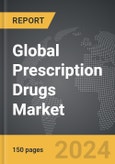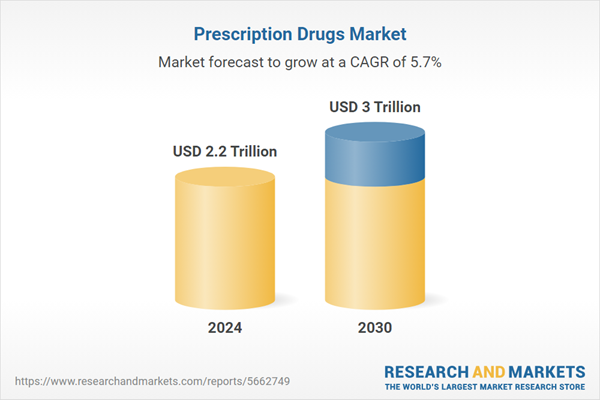Global Prescription Drugs Market - Key Trends and Drivers Summarized
The Intricate World of Prescription Drugs: From Lab to Pharmacy Shelf
Prescription drugs are pharmaceutical medications that require a medical prescription before they can be dispensed to patients. These drugs are rigorously regulated due to their potency, potential side effects, and the necessity for professional oversight in their use. The development of prescription drugs is a complex and lengthy process, beginning with extensive research and development (R&D). Scientists conduct preclinical studies to evaluate the drug’s safety and efficacy using laboratory and animal models. Once a drug shows promise, it enters clinical trials, which are conducted in three phases involving human subjects to further assess its safety, dosage, and effectiveness. This process can take several years and involves stringent oversight by regulatory bodies such as the Food and Drug Administration (FDA) in the United States or the European Medicines Agency (EMA) in Europe. Only after successfully passing these rigorous stages can a drug receive approval for commercial use, ensuring it meets the highest standards for patient safety and therapeutic efficacy.Why Are Prescription Drugs Crucial in Modern Medicine?
Prescription drugs play a vital role in modern medicine, offering targeted treatments for a wide range of health conditions, from acute illnesses to chronic diseases. They enable healthcare providers to manage, alleviate, and cure diseases that would otherwise severely impact patient quality of life. For instance, antibiotics can eradicate bacterial infections, antihypertensives help control high blood pressure, and antidepressants are used to manage mental health conditions. The precision and potency of these medications make them indispensable tools in medical practice. Furthermore, the development of specialized drugs, such as biologics and targeted therapies, has opened new frontiers in treating complex diseases like cancer, autoimmune disorders, and rare genetic conditions. These advancements not only improve patient outcomes but also contribute to the overall advancement of medical science, providing a deeper understanding of human health and disease mechanisms.How Are Innovations Transforming the Prescription Drug Landscape?
Innovations in the field of prescription drugs are continuously reshaping the pharmaceutical landscape, bringing forth new treatments and improving existing therapies. One significant trend is the rise of personalized medicine, where treatments are tailored to an individual’s genetic makeup, lifestyle, and environment. This approach enhances the efficacy and reduces the side effects of medications, as therapies are customized to work best for each patient. Advances in biotechnology are also contributing to the development of biologics - complex drugs made from living organisms - which offer new treatment options for conditions that were previously difficult to manage. Additionally, the integration of artificial intelligence (AI) and machine learning in drug discovery is accelerating the identification of potential new drugs, optimizing clinical trials, and predicting patient responses. These technological breakthroughs are not only making the drug development process more efficient but are also expanding the therapeutic possibilities, ensuring that patients have access to the most advanced and effective treatments available.What Factors Are Driving the Growth of the Prescription Drugs Market?
The growth in the prescription drugs market is driven by several factors that reflect advancements in medical science and shifts in healthcare demands. One of the primary drivers is the increasing prevalence of chronic diseases, such as diabetes, cardiovascular diseases, and cancer, which require ongoing medication for management and treatment. The aging global population is also contributing to market growth, as older individuals typically require more medical interventions and prescription medications. Technological advancements in drug discovery and development, including the use of AI and genomics, are accelerating the introduction of new and more effective therapies. Furthermore, the expansion of healthcare infrastructure in emerging markets is increasing access to prescription medications, driving demand. Regulatory support and expedited approval processes for breakthrough therapies are also facilitating faster market entry of new drugs. These factors, combined with the growing focus on personalized medicine and biologics, are propelling the prescription drugs market forward, ensuring continued innovation and improved patient care.Report Scope
The report analyzes the Prescription Drugs market, presented in terms of units. The analysis covers the key segments and geographic regions outlined below.Segments: Type (Generics, Orphan Drugs, Other Types); Therapy (Oncology, Anti-Diabetics, Sensory Organs, Immunosuppressants, Anticoagulants, Other Therapies).
Geographic Regions/Countries: World; United States; Canada; Japan; China; Europe (France; Germany; Italy; United Kingdom; Spain; Russia; and Rest of Europe); Asia-Pacific (Australia; India; South Korea; and Rest of Asia-Pacific); Latin America (Argentina; Brazil; Mexico; and Rest of Latin America); Middle East (Iran; Israel; Saudi Arabia; United Arab Emirates; and Rest of Middle East); and Africa.
Key Insights:
- Market Growth: Understand the significant growth trajectory of the Generics segment, which is expected to reach US$498.0 Billion by 2030 with a CAGR of a 5.5%. The Orphan Drugs segment is also set to grow at 6.4% CAGR over the analysis period.
- Regional Analysis: Gain insights into the U.S. market, valued at $580.9 Billion in 2024, and China, forecasted to grow at an impressive 9.2% CAGR to reach $668.3 Billion by 2030. Discover growth trends in other key regions, including Japan, Canada, Germany, and the Asia-Pacific.
Why You Should Buy This Report:
- Detailed Market Analysis: Access a thorough analysis of the Global Prescription Drugs Market, covering all major geographic regions and market segments.
- Competitive Insights: Get an overview of the competitive landscape, including the market presence of major players across different geographies.
- Future Trends and Drivers: Understand the key trends and drivers shaping the future of the Global Prescription Drugs Market.
- Actionable Insights: Benefit from actionable insights that can help you identify new revenue opportunities and make strategic business decisions.
Key Questions Answered:
- How is the Global Prescription Drugs Market expected to evolve by 2030?
- What are the main drivers and restraints affecting the market?
- Which market segments will grow the most over the forecast period?
- How will market shares for different regions and segments change by 2030?
- Who are the leading players in the market, and what are their prospects?
Report Features:
- Comprehensive Market Data: Independent analysis of annual sales and market forecasts in US$ Million from 2024 to 2030.
- In-Depth Regional Analysis: Detailed insights into key markets, including the U.S., China, Japan, Canada, Europe, Asia-Pacific, Latin America, Middle East, and Africa.
- Company Profiles: Coverage of players such as AbbVie, Inc., Allergan PLC, Amgen, Inc., AstraZeneca PLC, Bayer AG and more.
- Complimentary Updates: Receive free report updates for one year to keep you informed of the latest market developments.
Some of the 23 companies featured in this Prescription Drugs market report include:
- AbbVie, Inc.
- Allergan PLC
- Amgen, Inc.
- AstraZeneca PLC
- Bayer AG
- Boehringer Ingelheim GmbH
- Bristol-Myers Squibb Company
- Celgene Corporation
- Eli Lilly and Company
- F. Hoffmann-La Roche AG
- Gilead Sciences, Inc.
- GlaxoSmithKline PLC
- Johnson & Johnson
- Merck & Co., Inc.
- Novartis International AG
- Novo Nordisk A/S
- Pfizer, Inc.
- Sanofi
- Shire PLC
- Teva Pharmaceutical Industries Ltd.
Tariff Impact Analysis: Key Insights for 2025
Global tariff negotiations across 180+ countries are reshaping supply chains, costs, and competitiveness. This report reflects the latest developments as of April 2025 and incorporates forward-looking insights into the market outlook.The analysts continuously track trade developments worldwide, drawing insights from leading global economists and over 200 industry and policy institutions, including think tanks, trade organizations, and national economic advisory bodies. This intelligence is integrated into forecasting models to provide timely, data-driven analysis of emerging risks and opportunities.
What’s Included in This Edition:
- Tariff-adjusted market forecasts by region and segment
- Analysis of cost and supply chain implications by sourcing and trade exposure
- Strategic insights into geographic shifts
Buyers receive a free July 2025 update with:
- Finalized tariff impacts and new trade agreement effects
- Updated projections reflecting global sourcing and cost shifts
- Expanded country-specific coverage across the industry
Table of Contents
Companies Mentioned (Partial List)
A selection of companies mentioned in this report includes, but is not limited to:
- AbbVie, Inc.
- Allergan PLC
- Amgen, Inc.
- AstraZeneca PLC
- Bayer AG
- Boehringer Ingelheim GmbH
- Bristol-Myers Squibb Company
- Celgene Corporation
- Eli Lilly and Company
- F. Hoffmann-La Roche AG
- Gilead Sciences, Inc.
- GlaxoSmithKline PLC
- Johnson & Johnson
- Merck & Co., Inc.
- Novartis International AG
- Novo Nordisk A/S
- Pfizer, Inc.
- Sanofi
- Shire PLC
- Teva Pharmaceutical Industries Ltd.
Table Information
| Report Attribute | Details |
|---|---|
| No. of Pages | 150 |
| Published | April 2025 |
| Forecast Period | 2024 - 2030 |
| Estimated Market Value ( USD | $ 2.2 Trillion |
| Forecasted Market Value ( USD | $ 3 Trillion |
| Compound Annual Growth Rate | 5.7% |
| Regions Covered | Global |









